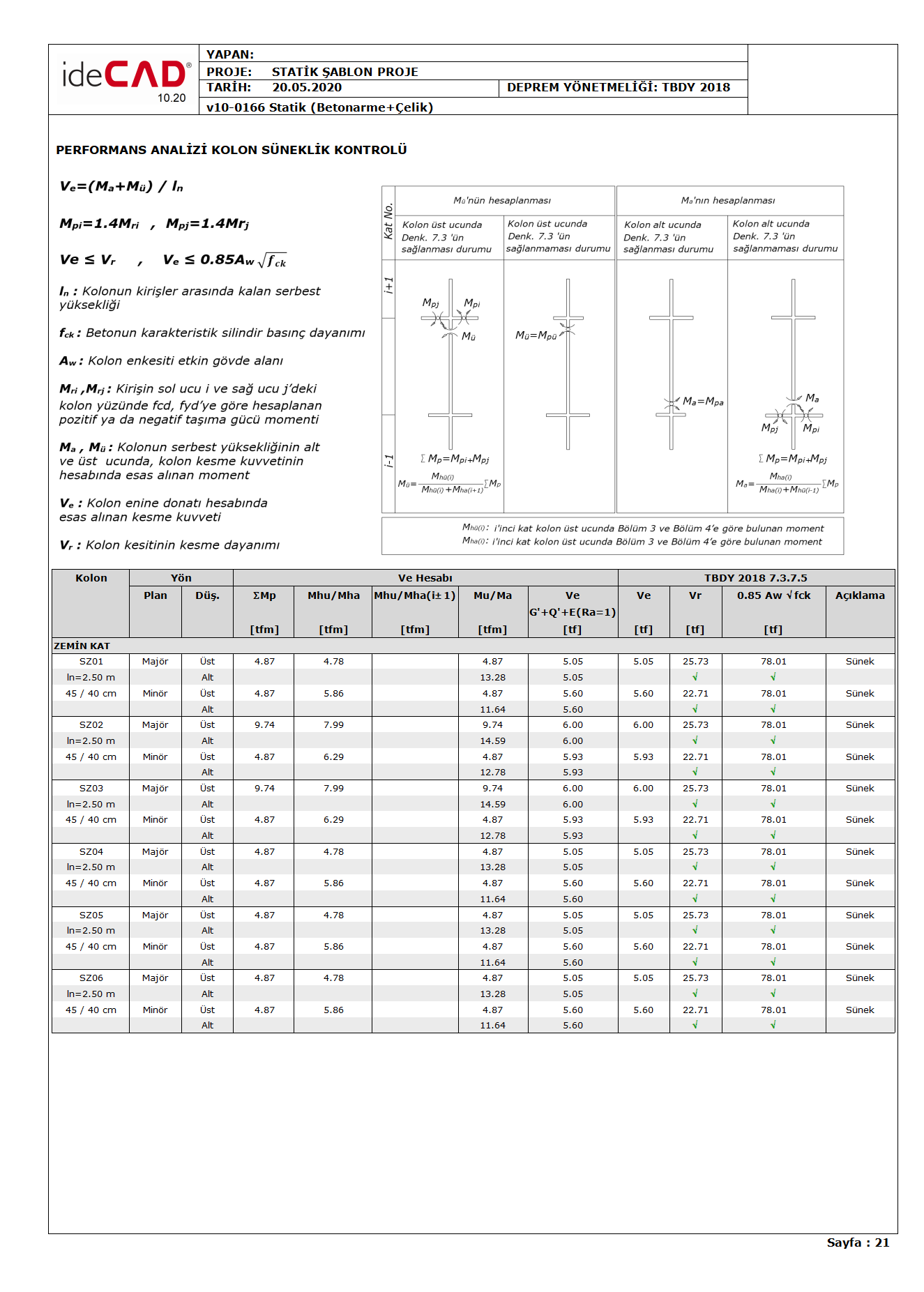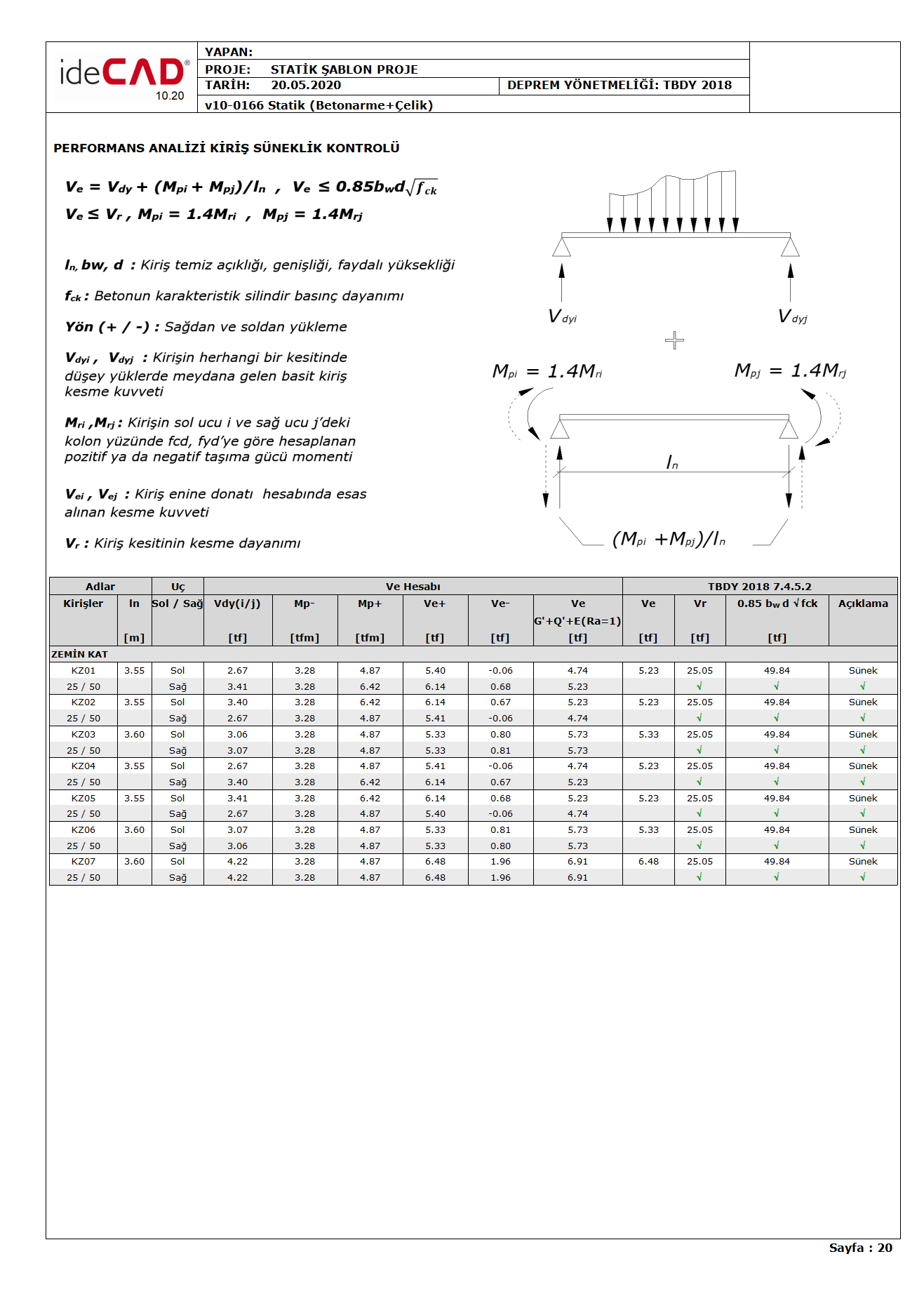15.5.2.2
In the performance analysis of existing buildings, in ductility control, the fracture type of reinforced concrete elements is classified as "ductile" if bending and "brittle" if shear is shear. While controlling the ductility of reinforced concrete elements in linear performance analysis, if the shear force value taken as the basis is greater than the shear strength, it is considered as brittle, if the shear force value taken as the basis is less than the shear strength, it is considered as a ductile element.
The ductility control of reinforced concrete elements is done automatically according to the element geometry and reinforcement placement.
The ductility control of the beams is done automatically according to the shear safety conditions of the beams .
The ductility control of the columns is done automatically according to the shear safety conditions of the columns .
The ductility control of the curtains is done automatically according to the shear safety conditions of the curtains .
ICONS
b w = Element body width
d = Element body width
f ck = Characteristic cylinder of concrete
l n = Free height of column between beams, free span ofbeambetween column or curtain faces
V e = Useful height of beam and column
V d = With vertical loads Theshear force under the joint effect of the earthquake effects calculated by takingR a = 1together,
V r =Shear strength of column, beam or wall section
M a = It is the moment value taken as basis in calculation of column shear force at the lower end of the column's stiffness height.
M ü = It is the moment value which is taken as basis in calculation of column shear force at the upper end of the free height of column.
M pi = Moment capacity at the face of the column at the left end i of the beam
M pj = Moment capacity at the column face at the right end j of the beam
( M p ) t = Moment capacity calculated at the base section of the wall
( M d) t = Bending moment under the joint effect of earthquake effects calculated by takingR a = 1together with the vertical loads at the base section of the wall
R a = Earthquake Load Reduction Coefficient
The fracture type of reinforced concrete elements is classified as bending as " ductile" and shear as " brittle" . For this reason, the ductility control of the elements is carried out in the performance analysis of the existing buildings where earthquake calculations will be made with linear calculation methods.
Columns, beams and ductile element pitch of the shearing force calculated in accordance with the bending capacity to be classified V e 's in Eq. (7.10) ' also must provide limits given. The V e value is calculated using the available material strength values in accordance with the knowledge level in columns, beams and walls .

V e calculation for columns is made according to the conditions of Shear Safety of Columns specified in TBDY Section 7.3.7 . In this case, V e value, which is the design shear force for columns, is calculated with Equation (7.5) . If the V e value calculated according to TBDY Section 7.3.7 meets the conditions in Equation (7.10) , it is classified as a ductile column, if not, it is classified as a brittle column. M a and M ü are the moment value which is taken as basis in calculation of column shear force at the lower and upper end of the free height of column , respectively. V e , M a and M ü for columns Column Shear Design Forces

V e calculation for beams is made according to the conditions of Shear Safety of Beams specified in Section 7.4.5 of TBDY . In this case, V e value, which is the design shear force for beams, is calculated by Equation (7.9) . M pi and M pj given in Eq. (7.9) are the moments of bearing power at the left end i and at the right end j of the beam. In TBDY Section 7.4.5 , M pi and M pj values are calculated taking into account the hardening effect. However, according to Article 15.5.2.2 (a) of TBDY , in linear performance analysis of existing structures, M pi and M Shear Strength of Beams

V e calculation for curtains is made according to the conditions of Shear Safety of Curtains specified in TBDY Section 7.6.6 . In this case, V e value, which is the design shear force for beams, is calculated by Equation (7.16) . However, contrary to what is stated in TBDY Section 7.6.6 , in linear performance analysis of existing structures , it is taken as v = 1. In Eq. (7.16) , ( M p ) t value is the moment capacity at the base section of the wall. This value is the current material strength, consistent with the knowledge level, without hardening effect. Shearwall Design Shear Forces

The shear force under the combined effect of the earthquake effects calculated by taking R a = 1 together with the vertical loads, the column calculated by Equation (7.5) , the beam calculated by Equation (7.9) and the shear force calculated with Equation (7.16) , the V e value. If it is small, this shear force is used instead of V e . If the V e value calculated at the end of all these comparisons satisfies Equation (7.10) , the element is classified as a ductile element. If one of the conditions of Equation (7.10) is not fulfilled, the element is classified as a brittle element.
In the pictures below, column, beam and curtain ductility checks in the evaluation of existing structures with earthquake calculation in line with the ŞGDT approach are shown.



Next Topic
